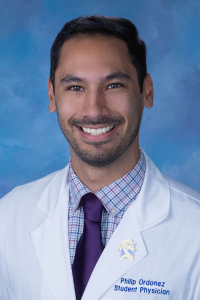Rooted in Bayanihan, Growing in Medicine: The Filipino Spirit in Healthcare
Published May 27, 2025
Inside OME

By Philip Ordoñez, OMS II, Nova Southeastern University Dr. Kiran C. Patel College of Osteopathic Medicine
I am on the path to becoming the first physician in my family, and I attribute much of my success to the foundation laid by those who came before me. My father was born in a small village in the Philippines and immigrated to the United States when he was just seventeen years old. In time, my grandparents, aunts and uncle also moved to the States, and together they helped lay a foundation for the next generation. Because of their hard work and sacrifices, my cousins and I have had the opportunity to reach even further.
My grandfather was a pastor, both in the Philippines and here in the United States. I believe that he, along with my grandmother, truly embodied the spirit of bayanihan, which is a Tagalog word that represents helping others and fostering a sense of community. Together, they lived a life of service, often putting the needs of others before their own, and this philosophy was passed down through generations. Perhaps this shared value of service and compassion is one reason why so many Filipinos enter the healthcare field. My aunt and cousin are both dedicated nurses, part of the staggering number of Filipino Americans that are found in the healthcare workforce. Their presence in hospitals and clinics is not only widespread but also reflects a culture deeply rooted in empathy and care for others.
Each year in May, I try to take time during AAPI Heritage Month to reflect on the strength and perseverance of those who came before me. The impact of Filipino healthcare workers, especially those who served through monumental challenges like the COVID-19 pandemic, is something I’ve come to appreciate more deeply as I progress through medical school. Like many in healthcare, their contributions often go unnoticed, yet they continue to serve as quiet leaders and role models of dedication and resilience. They have shown me that leadership in medicine has many faces. It can look like consistency, selflessness and showing up, day in and day out, for those in need.
As I continue on in my own journey, I carry this legacy with me. I have come to understand that my story isn’t just mine, but a path paved by my parents, a dream envisioned by my grandparents and the culmination of the efforts of so many before me. Becoming a physician is more than a career goal, it is a way to serve others, uplift my community and give back in a meaningful way. One day, I hope to honor the sacrifices of those who came before me by pushing the boundaries even further for those who follow. This AAPI Heritage Month, I not only want to recognize and celebrate the journeys of those who paved the way, but also look ahead with hope.
